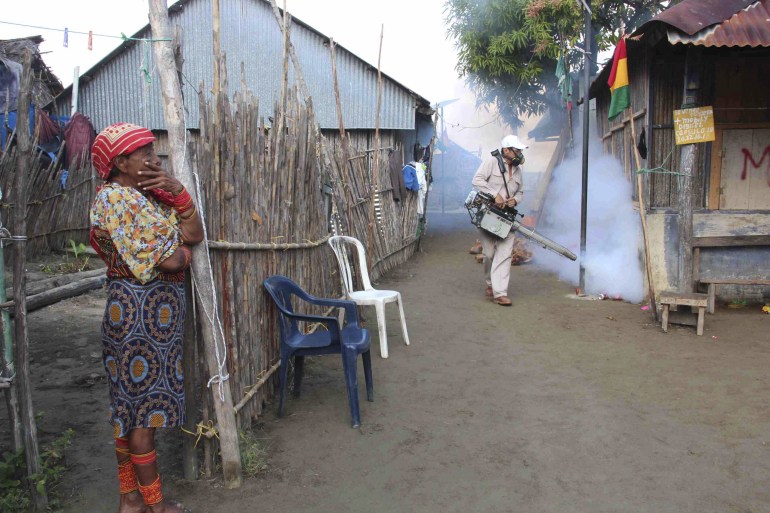In a 52-page report on Monday, Human Rights Watch (HRW) said “ongoing government delays” pose a serious threat to the human rights of Panama’s Indigenous Guna people.
According to the group’s findings, the government has repeatedly failed to provide housing and infrastructure to a new community site on higher ground, despite repeated assurances and plans stretching back to 2010.
“Panama should follow through on its promises and provide immediate support so the Gardi Sugdub community can relocate with dignity,” said Erica Bower, a climate displacement researcher at Human Rights Watch and author of the report.
“It’s not too late for the government to take this opportunity and create a blueprint that coastal communities elsewhere in Panama and globally can turn to as they confront the climate change crisis.”
Small island, big problems
Gardi Sugdub — or “Crab Island” — is part of an archipelago on Panama’s Caribbean coast expected to face “the most severe impacts” of climate change, according to the report.
At its highest point, the island is only one metre (3.2 feet) above sea level. And as the tides creep higher and higher, the island’s Guna residents are finding themselves with less and less space.
An estimated 1,300 Guna people are packed onto an island only 300 metres (984 feet) long and 125 metres (410 feet) wide. And yearly floods — lasting up to two weeks at a time — have caused significant damage to their homes and livelihoods.
“When I got home, the pier and the toilet had washed away,” one Gardi Sugdub resident, Eustacio Valdez, told Human Rights Watch, as he recalled one flood in 2008.
“The canoes were gone. There were high waves. It was flooded for a week. School was suspended.”

A difficult decision
In 2010, the Guna community on Gardi Sugdub arrived at a heavy conclusion: The only sustainable solution was to relocate to a different site.
“We are already too many in this town and we don’t fit,” Magdalena Martinez, secretary of the Neighborhood Committee on Gardi Sugdub, told Human Rights Watch. “There isn’t any more room.”
To house their growing population, Guna community members donated a site for the project on the mainland, nicknamed “Isperyala” for its abundance of loquat trees.
Around that time, Panama’s government also promised to build a “model school” and hospital for the area by 2014. But both have yet to be completed, according to Human Rights Watch.
In 2017, the Ministry of Housing likewise committed to building 300 homes for the Guna people, as well as providing services like potable water, sanitation and roads.
The project was originally slated to take 450 calendar days, according to Human Rights Watch. But then the onset of the COVID-19 pandemic slowed construction. A new completion date was set for September 2023. That too was delayed.
“The government is not complying with what it agreed to for this project. Look at that delay. That is not fair,” community member Dillion Navarro said in the report.
A measure of ‘last resort’
Meanwhile, on Gardi Sugdub, the Guna people struggle with overcrowding, a lack of educational resources for their children and unreliable access to fresh water, contributing to a high rate of gastrointestinal disease and poor sanitation.
The Human Rights Watch report noted that the conditions in Gardi Sugdub reflected hazards facing vulnerable coastal communities around the world.
“Even under the most optimistic scenarios of planetary warming, sea level rise is inevitable,” the report reads. “But planning today will mitigate some of the risks of tomorrow.”
The report adds that relocation is “a measure of last resort” for Indigenous communities, who often have strong ties to their homelands.
For the Guna, the islands provided sanctuary from centuries of colonial oppression. Starting in 1650, missionaries forced their people into settlements. Spanish colonisers confronted them with violence. And later, the Panamanian government attempted to suppress their traditional ways.
The islands also allowed the Guna to escape the mosquito-borne diseases common on the mainland.
But conditions on Gardi Sugdub are only expected to worsen due to climate change.

A widespread crisis
Human Rights Watch has estimated that at least 38 other islands in Guna Yala — the Guna’s ancestral territory — will soon require relocation, as well, due to climbing sea levels. That includes a total of approximately 28,000 people.
And the Guna are hardly alone in facing this plight. The report noted that climate risks and other threats have prompted more than 400 planned relocations worldwide.
But, the report concludes, results have been slow to materialise for the Guna: “To date, not a single person has moved.”
It calls for “immediate support” to be given to the Guna people, as they contend with the worsening crisis.
